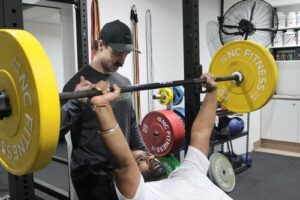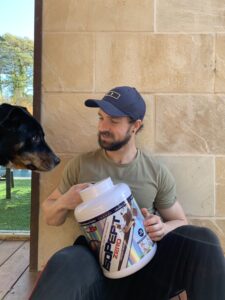
7 Insider Fitness Tips Trainers Aren’t Telling You

Want to know the secrets trainers aren’t telling you? Fitness tips they aren’t telling you so you feel like you NEED to hire them? Well let me run you through 7 insider fitness tips that will help you improve your fitness that trainers won’t want you knowing:
1. Walking is the most underrated form of exercise
If your trainer is telling you not to worry about going on those walks, that you should be running or going to the gym…fire them. Increasing your step count is going to help improve your NEAT, which can account for up to 50% of your daily total energy expenditure (TDEE) depending on your lifestyle.
Not only does walking contribute to your TDEE, but it helps improve movement and aerobic fitness, clear your mind, reset your focus. Setting a reminder on your phone to get up and walk around every hour can drastically change your overall health, both physically and mentally.
2. Training to failure is detrimental to your progress
Your workout quality is determined by your ability to walk out of the gym, right? Wrong.
Simply put, our muscles require a reason to adapt to the stimuli (training protocols) and it does this during our recovery phase. We need to create enough reason to force the muscle to adapt and the way to do this is exhausting the muscle.
“But wait, I thought you said don’t train to fatigue?”
That’s correct. Research shows that the same muscle growth, or ‘hypertrophy’, occurs when you leave just a little left in the tank after each set. This is called ‘Reps In Reserve’ (RIR). For example, if you could maximal curl a dumbbell 10 times before failing the rep, your RIR would be 0. And if you stopped at 8 reps instead of 10, that would be 2RIR, and that’s approximately the amount you want to work too.
Recovery is also important as this is when your muscles go through protein synthesis (building protein) and it allows for the rest of your body to recover back towards its ‘baseline’. It takes time for your body to do this, and the more fatigued our muscles/body, the longer it takes.
When you leave 2RIR compared to going to failure, your allowing your body the ability to recover properly before getting back into the gym and training again. You’re more likely to maximise your session when your body is closer to its ‘baseline’ homeostasis rather than if you are still sore from your last workout.
3. Increase your calories to burn more
This might sound counter productive, but it does apply to a lot of people who haven’t focused on their nutrition properly.
Let me run you through a client I have at the moment, ‘Client Q’.
Client Q has been training with me for a few years now, and achieving her goal of dropping body fat. This was all good until she hit a plateau. The problem was not her motivation, strength, or commitment. The issue was the low amount of calories she had worked her way down to while she was dieting.
Simply put, to lose weight: calories consumed must be less than calories used by the body. The problem with this is that we can’t keep dropping our calories down to make progress. So by the time she showed me her nutrition and how much she was eating (around 1,100 calories per day!), her basal metabolic rate had decided to slow down (again this is simply put, it gets more complicated than this). We want to increase her BMR so that she can eat more and still be in a caloric deficit.
So although she was nervous to do so, we started slowly bumping up her calories, and these were the results:
She started eating more food and enjoying it
She started training harder in the gym from all the extra energy
She started feeling better AFTER her training and recovered better
She started gaining more strength by using all the extra energy
Her BMR and Activity thermogenesis (read about NEAT in point 1) increased, meaning she could burn more calories and eat more.
This process can be tricky, but if done correctly it can also have a major impact on your training, nutrition and results. Take note that this process is not necessary for everyone, and if you are wondering if this is for you, click HERE to book in a FREE consultation to find out.
4. Weight Training will help you move better, not burn calories
I’ll keep this one shorter. Weight training should not be your way of burning calories. Yes, you will burn calories, but it’ll only be very little compared to the rest of your day. The goal every time you go to the gym should be to improve the way you move and the structure of your bones, ligaments and muscles.
If you want to be in a caloric deficit, control how many calories you consume each day.
5. Bodyweight training can be just as, if not more, beneficial for strength gains than weight training
Can you do a push up? What about a pull up? If you answered ‘no’ to either of these, bodyweight training will help you. If you answered ‘yes’ to either of these, bodyweight training can also help you.
What’s so good about body weight training?
Well for starters, a large selection of the population don’t have the strength or technique to perform certain movements (like push ups or chin ups) and the best way to improve in these exercises is to, well…practice them.
They also require ZERO equipment and can be done just about anyway. Yes, its easier to do pull ups & chin ups with a bar, BUT you can use everyday household items such as a a door, piping or even overhanging sections of your house.
6. Fats and Carbs are not the enemy
Calories consumed must be less than calories used by the body to achieve fat loss. The only important macronutrient is protein, and as long as you are having the recommended amount of that per day (1.5-2.2g per kg of you bodyweight), then you can split up the other two macronutrients however you like.
Do be wary of too much bad fats though (Saturated and Trans Fats) and sugar, as they will have other detrimental effects on your body.
7. You don’t need supplements to succeed
Despite what the fitness industry is telling you, you don’t need to spend $200 a month on supplements to achieve your goals. In fact, the only three supplements that you should consider is whey protein, creatine and/or pre-workout/caffeine. The reason for this is because they are the only supplements that have enough evidential research behind them to actually do something for your body. Although these supplements will make your life easier, you still don’t need them.
There’s my 7 insider tips that will help get you moving, get you seeing results, and prevent you from wasting too much time and money on the wrong ‘miracle answers’.
Leave a Replay
Key Points
-
Walk More
-
Don't Train to Failure
-
Increase Your Calories to Burn More
-
Weights Improve Movement
-
Bodyweight Training is Also Beneficial
-
Don't Avoid Fats & Carbs
-
You Don't Need Supplements

